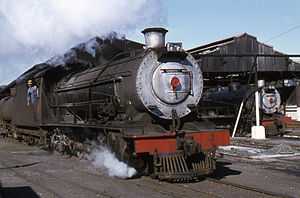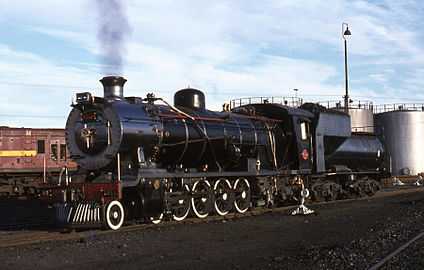South African Class 14A 4-8-2
| South African Class 14A 4-8-2 & South African Class 14R 4-8-2 | |
|---|---|
|
Class 14R no. 1905 at Klerksdorp, Transvaal, 17 April 1978 | |
| Type and origin | |
| Power type | Steam |
| Designer | South African Railways |
| Builder | North British Locomotive Company |
| Serial number | 20568-20587, 20822-20842 [1][2] |
| Model | Class 14A |
| Build date | 1914 [1] |
| Total produced | 41 |
| Specifications | |
| Configuration | 4-8-2 "Mountain" |
| Gauge | 3 ft 6 in (1,067 mm) Cape gauge |
| Leading wheel diameter | 28.5 in (724 mm) |
| Driver diameter | 48 in (1,220 mm) |
| Trailing wheel diameter | 33 in (838 mm) |
| Wheelbase |
Total: 56 ft 11.75 in (17.367 m) Engine: 6 ft 2 in (1.880 m) bogie 12 ft 9 in (3.886 m) coupled 30 ft 7 in (9.322 m) total Tender: 4 ft 7 in (1.397 m) bogie 16 ft 9 in (5.105 m) total |
| Length | 65 ft 4.625 in (19.929 m) |
| Height |
12 ft 10 in (3.912 m) as built 12 ft 11.75 in (3.956 m) reboilered |
| Axle load |
15 long tons (15.2 t) on 2nd driver as built 16.5 long tons (16.8 t) on 2nd driver reboilered, copper firebox 15.8 long tons (16.1 t) on 2nd driver reboilered, steel firebox |
| Weight on drivers |
59.85 long tons (60.8 t) as built 63.65 long tons (64.7 t) reboilered, copper firebox 60.7 long tons (61.7 t) reboilered, steel firebox |
| Locomotive weight |
85.5 long tons (86.9 t) as built 90.2 long tons (91.6 t) reboilered, copper firebox 87.3 long tons (88.7 t) reboilered, steel firebox |
| Tender weight |
48,864 lb (22.2 t) empty 52.35 long tons (53.2 t) w/o |
| Locomotive and tender combined weight |
178,100 lb (80.8 t) empty 137.85 long tons (140.1 t) w/o |
| Tender type |
MR - MP, MP1, MR, MS, MT, MT1, MT2, MX, MY, MY1 permitted * 2 axle bogies * 34 in (864 mm) wheels * Length 25 ft 9.75 in (7.868 m) |
| Fuel type | Coal |
| Fuel capacity | 10 long tons (10.2 t) |
| Water capacity | 4,600 imp gal (21,000 l) |
| Boiler |
As built: 5 ft 1.625 in (1.565 m) inside diameter 19 ft (5.791 m) inside length 7 ft 7 in (2.311 m) pitch Reboilered: 5 ft 7.5 in (1.715 m) inside diameter 19 ft 4 in (5.893 m) inside length, steel firebox 19 ft 3.625 in (5.883 m) inside length, copper firebox 8 ft 0.5 in (2.451 m) pitch |
| Boiler pressure |
180 psi (1,240 kPa) as built 190 psi (1,310 kPa) reboilered |
| Firegrate area | 37 sq ft (3.437 m2) |
| Heating surface: – Tubes |
As built: 118 tubes 2.25 in (57.1 mm) diameter 21 tubes 5.5 in (140 mm) diameter 1,909 sq ft (177.352 m2) Reboilered: 87 tubes 2.5 in (63.5 mm) diameter 30 tubes 5.5 in (140 mm) diameter 1,933 sq ft (179.582 m2) |
| – Firebox |
150 sq ft (13.935 m2) as built 142 sq ft (13.192 m2) reboilered |
| – Total |
2,059 sq ft (191.287 m2) as built 2,075 sq ft (192.774 m2) reboilered |
| Superheater area |
483 sq ft (44.872 m2) as built 492 sq ft (45.708 m2) reboilered |
| Cylinders | Two |
| Cylinder size |
21 in (533 mm) bore 26 in (660 mm) stroke |
| Valve gear | Walschaerts |
| Performance figures | |
| Tractive effort |
At 75% boiler pressure: 32,250 lbf (143.5 kN) as built 37,360 lbf (166.2 kN) reboilered [3] |
| Career | |
| Operator(s) | South African Railways |
| Class | Class 14A, Class 14R |
| Number in class | 41 |
| Number(s) | 1576-1595, 1901-1921 |
| Delivered | 1914-1915 |
| First run | 1914 |
The South African Class 14A 4-8-2 of 1914 is a South African steam locomotive from the South African Railways era.
In 1914 and 1915 the South African Railways placed forty-one Class 14A steam locomotives with a 4-8-2 Mountain type wheel arrangement in service.[4]
Manufacturer
Following the success of the Class 14, D.A. Hendrie, then the Chief Mechanical Engineer (CME) of the South African Railways (SAR), used the design as basis for the lighter Class 14A locomotive for use on coastal lines. The second version of the Class 14 locomotive was ordered from the North British Locomotive Company (NBL) in 1913 and was built in two batches. Twenty were delivered in 1914, numbered in the range from 1576 to 1595, and another twenty-one in 1914 and 1915, numbered in the range from 1901 to 1921.[2]
Like the Class 14, the Class 14A had Walschaerts valve gear and a Belpaire firebox and was superheated, but it had nearly 6 inches (152 millimetres) less boiler diameter than the Class 14 in order to reduce the axle loading to 15 long tons (15.2 tonnes), specifically for use on the lighter track on the Cape Eastern mainline from East London. To compensate for the smaller boilers, they were equipped with smaller cylinders with a bore of 21 inches (533 millimetres) instead of 22 inches (559 millimetres).[2][4][5]
Watson Standard boilers
During the 1930s many serving locomotives were reboilered with a standard boiler type designed by then CME A.G. Watson as part of his standardisation policy. Such Watson Standard reboilered locomotives were reclassified by adding an "R" suffix to their classification.[3][4]
All the Class 14A locomotives except number 1915 were eventually reboilered with Watson Standard no 2 boilers. In the process they were also equipped with Watson cabs, with their distinctive slanted fronts, compared to the conventional vertical fronts of their original cabs. In spite of being lighter than the Class 14, they were reclassified to Class 14R along with reboilered Class 14 locomotives, instead of to Class 14AR. Even so, they could still be identified as ex Class 14A locomotives by the absence of sandboxes on their running boards.[3][4]
An obvious visual difference between an original and a Watson Standard reboilered locomotive is usually a rectangular regulator cover just to the rear of the chimney on the reboilered locomotive. In the case of reboilered Class 14A locomotives two even more obvious visual differences are the Watson cab and the absence of the Belpaire firebox hump between the cab and boiler on the reboilered locomotives.[3]
Service
South African Railways
As intended, the Class 14A was placed in service on the East London mainline, but although they were good locomotives, they were not very successful there and were soon relocated to be shared between the Cape Western system for use between Cape Town and Beaufort West, and the Eastern Transvaal system for use on the line to Delagoa Bay out of Pretoria, particularly between Waterval Boven and Komatipoort. The Cape Western locomotives later joined the rest of the Class in the Eastern Transvaal. They proved themselves as free steaming locomotives, low on maintenance costs and trouble-free, and therefore popular with crews and fitters alike.[2][4]
Industrial
Six were eventually sold into industrial service.
- No. 1586 went to Rustenburg Platinum Mines, retaining its SAR number.
- No. 1589 became "Bob" at the Vaal Reefs Gold Mine.
- No. 1906 became Randfontein Estates Gold Mine no. 6.
- No. 1908 became Apex Colliery no. 4 at Greenside.
- No. 1918 went to St Helena Gold Mines.
- No. 1921 became Grootvlei Proprietary Mines Limited no. 3, "Duggie".[5]
Service illustrated
The main picture shows second order Class 14R no. 1905 at Klerksdorp, Transvaal, on 17 April 1978. The first of the following pictures illustrate the Class 14A locomotive as built, while the rest show reboilered Class 14R locomotives in service.
-
_Playing_Cards.jpg)
First order no. 1578, as built with a Belpaire firebox, depicted on a SAR Museum playing card
-
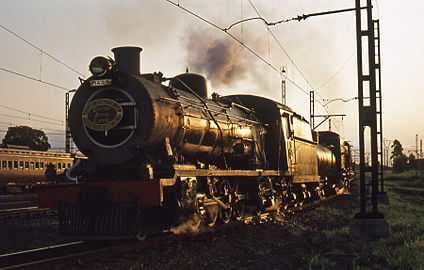
First order no. 1590 named "Mary" at Cato Ridge, Natal, 24 March 1978
-
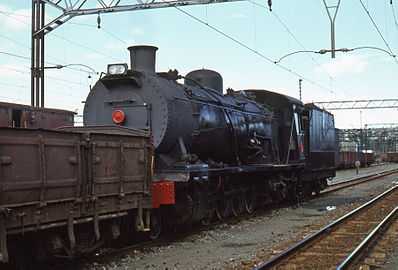
First order no. 1592 at Mason’s Mill, Pietermaritzburg, 29 March 1979
-
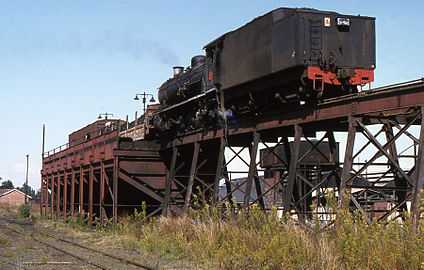
Second order no. 1907 on the coaling stage at Klerksdorp, Transvaal, 17 April 1978
- ^ Cite error: The named reference
Durrantwas invoked but never defined (see the help page).
See also
- List of South African locomotive classes
- South African Class 14 4-8-2
- South African Class 14B 4-8-2
- South African Class 14C 4-8-2
- South African locomotive history
- Tender locomotive numbering and classification
- The 4-8-2 "Mountain"
- Watson Standard boilers
References
|
- ↑ 1.0 1.1 North British Locomotive Company works list, compiled by Austrian locomotive historian Bernhard Schmeiser
- ↑ 2.0 2.1 2.2 2.3 Holland, D.F. (1972). Steam Locomotives of the South African Railways, Volume 2: 1910-1955 (1st ed.). Newton Abbott, Devon: David & Charles. p. 24. ISBN 978-0-7153-5427-8.
- ↑ 3.0 3.1 3.2 3.3 South African Railways and Harbours Locomotive Diagram Book, 2’0” & 3’6” Gauge Steam Locomotives, 15 August 1941, as amended
- ↑ 4.0 4.1 4.2 4.3 4.4 Paxton, Leith; Bourne, David (1985). Locomotives of the South African Railways (1st ed.). Cape Town: Struik. pp. 10–11, 57–58. ISBN 0869772112.
- ↑ 5.0 5.1 Durrant, A E (1989). Twilight of South African Steam (1st ed.). Newton Abbott, London: David & Charles. pp. 63–64. ISBN 0715386387.
